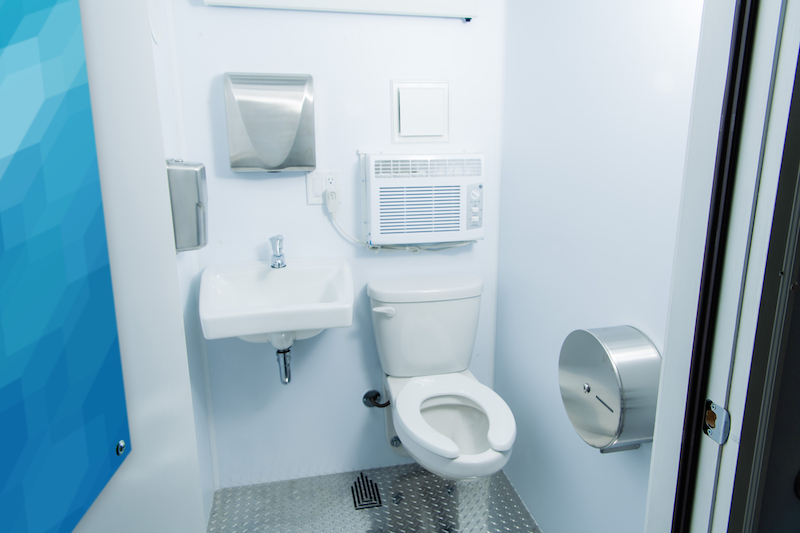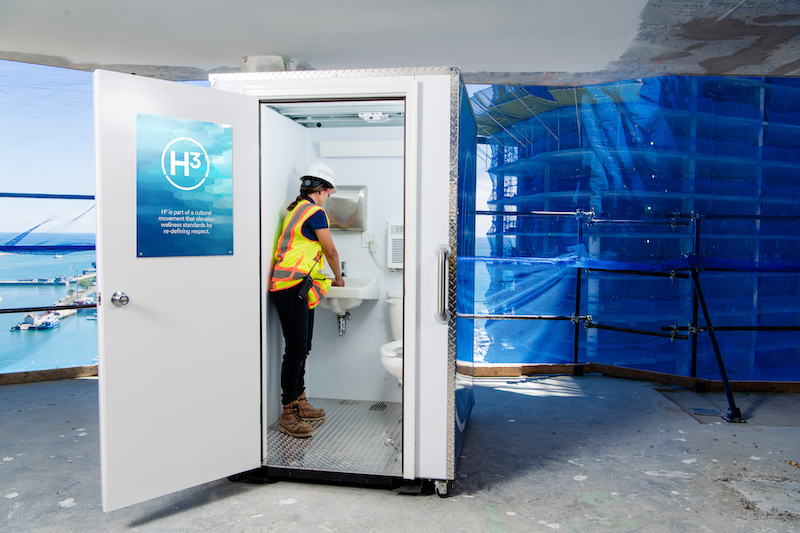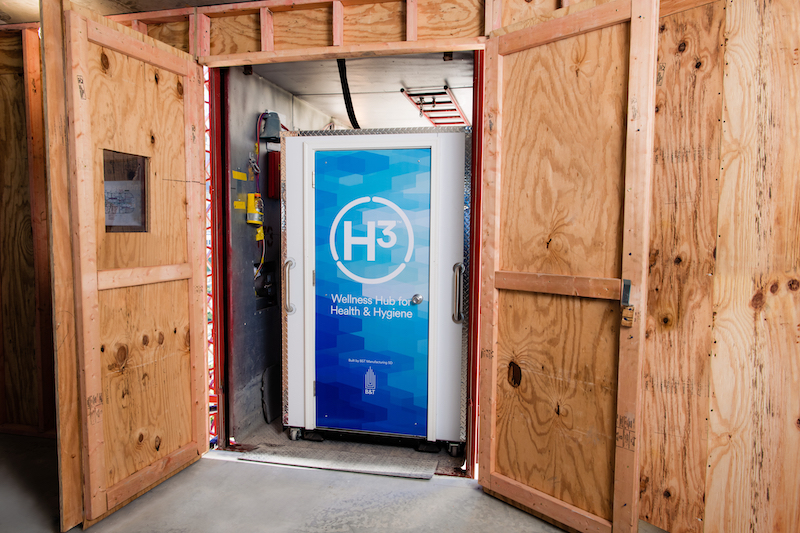In the annals of jobsite productivity, the portable restroom—better known as a porta potty or Porta John—has played a prominent, if underappreciated, role.
Dating back to the 1940s, these single-occupant restrooms within fiberglass boxes are essential fixtures in construction management. And there have been advances along the way: in 2016, for example, a New York-based supplier named Callahead introduced Waterloo, a self-contained system that Callahead touted as giving users the look, feel, and comfort of a home bathroom.
But portable restrooms can’t always be conveniently placed, especially on high-rise projects where bathroom breaks can be an arduous, time-consuming process.
BUILT TO ACCOMMODATE TIGHT SPACES
Lendlease thinks it’s found a solution to this dilemma with its H3 Wellness Hub, a modular bathroom system whose design optimizes mobility, installation, and maintenance. (The three “H”s stand for hub, health, and hygiene.)
Lendlease invented H3, and has licensed its exclusive manufacturer, B&T Manufacturing in Black Hawk, S.D., to market and sell the units that are 60-1/8 x 49 x 82 inches (length, width, height, outside) and 49 x 44-1/4 x 75 inches (inside). Lendlease started rolling out H3s last November and there are currently eight in the field and 11 more scheduled for delivery within the next month in New York, Los Angeles, San Francisco, and Chicago.
B&T is in negotiations with other Porta John suppliers and subcontractors.
The H3s are designed to accommodate tight spaces. They can fit in a construction hoist or be lifted by crane vertically onto a project’s site. Their built-in wheel system can lock in place or be rolled around for versatile positioning.
MULTIPLE HOOKUP OPTIONS
 Chemicals aren't needed to clean the interior of H3s, which can by connected to septic tanks or city utilities.
Chemicals aren't needed to clean the interior of H3s, which can by connected to septic tanks or city utilities.
The units provide an enclosed, climate-controlled space that can be connected to standalone septic tanks or directly, on single or multiple floors, to sanitation, fresh water, and electrical utility risers. Conventional cleaning materials can be used, thereby eliminating the need for chemicals that are common in most portable restrooms. (A wall-mounted toilet allows for obstruction-free floor cleaning.)
H3s include HVAC, hot water, natural lighting (via a translucent roof), and porcelain fixtures. UV options are available for germ and bacteria prevention.
Tim Torpey, B&T’s general manager, tells BD+C that his company isn’t sharing pricing information publicly, preferring instead to have customers call and request a price quote. Torpey adds that B&T is offering volume discounts.
 The units are designed to make personal hygiene more convenient for jobsite workers.
The units are designed to make personal hygiene more convenient for jobsite workers.
Related Stories
| Aug 11, 2010
America's Greenest Hospital
Hospitals are energy gluttons. With 24/7/365 operating schedules and stringent requirements for air quality in ORs and other clinical areas, an acute-care hospital will gobble up about twice the energy per square foot of, say, a commercial office building. It is an achievement worth noting, therefore, when a major hospital achieves LEED Platinum status, especially when that hospital attains 14 ...
| Aug 11, 2010
Concrete Solutions
About five or six years ago, officials at the University of California at Berkeley came to the conclusion that they needed to build a proper home for the university's collection of 900,000 rare Chinese, Japanese, and Korean books and materials. East Asian studies is an important curriculum at Berkeley, with more than 70 scholars teaching some 200 courses devoted to the topic, and Berkeley's pro...
| Aug 11, 2010
Piano's 'Flying Carpet'
Italian architect Renzo Piano refers to his $294 million, 264,000-sf Modern Wing of the Art Institute of Chicago as a “temple of light.” That's all well and good, but how did Piano and the engineers from London-based Arup create an almost entirely naturally lit interior while still protecting the priceless works of art in the Institute's third-floor galleries from dangerous ultravio...
| Aug 11, 2010
Precast All the Way
For years, precast concrete has been viewed as a mass-produced product with no personality or visual appeal—the vanilla of building materials. Thanks to recent technological innovations in precast molds and thin veneers, however, that image is changing. As precast—concrete building components that are poured and molded offsite—continues to develop a vibrant personality all it...
| Aug 11, 2010
Bronze Award: John G. Shedd Aquarium, Chicago, Ill.
To complete the $55 million renovation of the historic John G. Shedd Aquarium in the allotted 17-month schedule, the Building Team had to move fast to renovate and update exhibit and back-of-house maintenance spaces, expand the visitor group holding area, upgrade the mechanical systems, and construct a single-story steel structure on top of the existing oceanarium to accommodate staff office sp...
| Aug 11, 2010
AIA Course: Building with concrete – Design and construction techniques
Concrete maintains a special reputation for strength, durability, flexibility, and sustainability. These associations and a host of other factors have made it one of the most widely used building materials globally in just one century. Take this free AIA/CES course from Building Design+Construction and earn 1.0 AIA learning unit.
| Aug 11, 2010
Great Solutions: Green Building
27. Next-Generation Green Roofs Sprout up in New York New York is not particularly known for its green roofs, but two recent projects may put the Big Apple on the map. In spring 2010, the Lincoln Center for the Performing Arts will debut one of the nation's first fully walkable green roofs. Located across from the Juilliard School in Lincoln Center's North Plaza, Illumination Lawn will consist ...
| Aug 11, 2010
Pioneer Courthouse: Shaking up the court
In the days when three-quarters of America was a wild, lawless no-man's land, Pioneer Courthouse in Portland, Ore., stood out as a symbol of justice and national unity. The oldest surviving federal structure in the Pacific Northwest and the second-oldest courthouse west of the Mississippi, Pioneer Courthouse was designed in 1875 by Alfred Mullett, the Supervising Architect of the Treasury.
| Aug 11, 2010
Gold Award: Eisenhower Theater, Washington, D.C.
The Eisenhower Theater in the John F. Kennedy Center for the Performing Arts in Washington, D.C., opened in 1971. By the turn of the century, after three-plus decades of heavy use, the 1,142-seat box-within-a-box playhouse on the Potomac was starting to show its age. Poor lighting and tired, worn finishes created a gloomy atmosphere.
| Aug 11, 2010
Giants 300 University Report
University construction spending is 13% higher than a year ago—mostly for residence halls and infrastructure on public campuses—and is expected to slip less than 5% over the next two years. However, the value of starts dropped about 10% in recent months and will not return to the 2007–08 peak for about two years.







